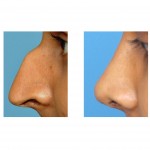A good looking nose is about balance of its many nasal parts, particularly the three thirds of the nose. One of these, the upper third, also known as the bridge is a frequent source of dissatisfaction. When it is overgrown or too high, a hump or bump on the nose results. In rhinoplasty terms this is referred to as a high dorsum. When the dorsum is high relative to the rest of the nose, the dorsal line (line from the bridge of the nose to the tip) is curved rather than not straight. This creates an unpleasing profile and makes the nose look too big.
When a nasal hump deformity is combined with a plunging tip, a hooked nose results. In profile, the nose is convex with a nasolabial angle that is less than 90 degrees. This type of nasal shape can also be called a witch’s nose. The hooked nose can also create the appearance that one’s chin is short. (pseudo microgenia) This becomes particularly magnified when the chin is actually horizontally short in projection.
A hump reduction (dorsal management)is an integral part of rhinoplasty correction in the hook nose. The hump is a combination of bone and cartilage as the hump occurs where the bone of the nose stops and the cartilage of the nose begins. This may seem like a trivial anatomic point but reducing this area involves removing both. Taking the hump down lowers the dorsal line and often requires osteotomies (breaking the nasal bones) to close down the open roof deformity which frequently results.

There are also small rhinoplasty techniques that can help both the hump and tip changes. Adding a cartilage graft to the radix (upper part of the hump) as well as at the base of the nose (opening up the nasolabial angle) helps further refine and enhance smaller, less often appreciated, deficiencies in the hook nose.
Like all rhinoplasties, consideration of adequate chin projection is important. This is particularly so in the hook nose which is larger and disproportionate to the rest of the face. This is not an illusion. Even in those that may only be slightly so, chin augmentation (usually by an implant) can make a dramatic facial profile difference as it makes the nose appear less large.
Hooked nose correction involves a variety of nose and chin changes. Hump reduction alone is inadequate and must be combined with top rotation and shortening and crushed cartilage augmentation to the radix and anterior nasal spine areas. Chin augmentation completes the correction and at least 5 to 7mms of increase is needed in most cases.
Dr. Barry Eppley
Indianapolis Indiana


